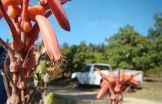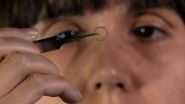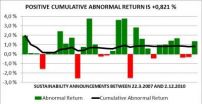(Press-News.org) Scientists have discovered 100 million-year-old regions in the DNA of several plant species which could hold secrets about how specific genes are turned 'on' or 'off'.
The findings, which are hoped will accelerate the pace of research into crop science and food security, are detailed by University of Warwick researchers in the journal The Plant Cell.
By running a computational analysis of the genomes of the papaya, poplar, Arabidopsis and grape species, scientists have uncovered hundreds of conserved non-coding sequences which are found in the DNA of all four species.
These non-coding sequences are not genes, but are located in the promoters upstream of genes and are around 100 DNA base pairs in length.
As the four species have evolved separately for around 100 million years, the fact that these regions have been conserved suggests they play an important role in the plants' development and functioning.
The team at the University of Warwick believe these regions are involved in controlling the expression of the genes they are upstream of - in other words determining whether the genes are turned 'on' or 'off' according to the environmental conditions or developmental stage of the plant.
For example, some genes will be required for defence against pathogens, or others will be required for germination.
Dr Sascha Ott of the Warwick Systems Biology Centre said: "We know that certain genes are conserved between species – but we also see that sequences outside of genes are conserved.
"The regions outside genes that we have discovered have been kept for millions and millions of years across four species.
"There must be a reason for this – if something has been around for so long it is probably useful in some way.
"We believe it may be because these regions have a very important role to play in how the plant develops and functions.
"It is likely that they are involved in controlling gene expression – a vital area for scientists to study as it will ultimately help us to develop crops with specific properties, for example drought tolerance.
"By pinpointing these specific regions, we have zoomed in on what seems to be a very old, and very important, part of DNA.
"We have opened up a short-cut as with this information, the biology community can now focus their experiments on specific regions next to genes which are key targets for plant breeding, and could play an important part in addressing the issue of food security.
"This discovery can be used to underpin future research focusing on working out regulatory codes and link sequence patterns to expression patterns."
###
This research was supported through the BBSRC/EPSRC grant Plant Responses to Environmental Stress in Arabidopsis (PRESTA).
The paper, Conserved Noncoding Sequences Highlight Shared Components of Regulatory Networks in Dicotyledonous Plants is published online here doi: http://dx.doi.org/10.1105/tpc.112.103010
Dr Sascha Ott is available on +44 (0)2476 150258 or s.ott@warwick.ac.uk
Anna Blackaby, University of Warwick press officer, is available on +44 (0)2476 575910 or +44 (0)7885 433155 or a.blackaby@warwick.ac.uk
A combined team of scientists from Europe and South Africa (Luísa G. Carvalheiro (University of Leeds, UK & Naturalis Biodiversity Research Centre, Netherlands), Colleen Seymour and Ruan Veldtman (SANBI, South Africa) and Sue Nicolson (University of Pretoria)) have discovered that pollinator services of large agriculture fields can be enhanced with a simple cost-effective measure, that involves the creation of small patches of native plants within fruit orchards.
"Mango farmers in South Africa are aware of the pollination limitation of this crop and invest a substantial ...
In research published in the journal Acta Biomaterialia, researchers from the University of Sheffield describe a new method for producing membranes to help in the grafting of stem cells onto the eye, mimicking structural features of the eye itself. The technology has been designed to treat damage to the cornea, the transparent layer on the front of the eye, which is one of the major causes of blindness in the world.
Using a combination of techniques known as microstereolithography and electrospinning, the researchers are able to make a disc of biodegradable material which ...
Experts already know that pregnant women should not eat for two. A study now insists on the importance of a healthy diet as a way of avoiding increased insulin and glucose levels in the child, both of which are indicators of diabetes and metabolic syndrome risk.
Maternal diet quality during pregnancy is fundamental to foetal growth as well as insulin and glucose levels at birth. Such indications warn of the possible predisposition to suffer from illnesses like diabetes and metabolic syndrome.
The study was headed by the Complutense University of Madrid and published ...
Scientists have demonstrated a new way to investigate mechanisms at work in Alzheimer's and other neurodegenerative diseases, which also could prove useful in the search for effective drugs. For new insights, they turned to the zebrafish, which is transparent in the early stages of its life. The researchers developed a transgenic variety, the "MitoFish," that enables them to see – within individual neurons of living animals – how brain diseases disturb the transport of mitochondria, the power plants of the cell.
Neurodegenerative diseases such as Alzheimer's, Parkinson's, ...
Sustainable business innovation is good business; researchers from Aalto University, Finland have proved. The researchers tested how sustainability business innovations and the market value of companies in the construction sector are connected. The study is a first of its kind. An event study model was used to analyse large construction sector companies in several European countries as well as Australia.
The most important finding of the study is that a positive and statistically significant association exists between sustainability innovation announcements and the market ...
The sense of immersion in role-play and computer games is sometimes viewed as dangerous, as players' strong perceptions of fictional worlds are assumed to make them lose contact with reality. On the other hand, players' immersion also implies a potential for improved learning, since it enables them to 'experience' new places and historical eras. Yet a new study from the University of Gothenburg, Sweden, shows that immersion in online role-play games requires a lot of hard work.
Gaming researcher Jonas Linderoth, at the Department of Education, Communication and Learning, ...
A recent clinical trial found that the adult antiviral drug, tenofovir disoproxil fumarate (tenofovir DF), is safe and effective in treating adolescents with hepatitis B virus (HBV). Trial results published in the December issue of Hepatology, a journal of the American Association for the Study of Liver Diseases (AASLD), show that tenofovir DF suppressed HBV in 89% of pediatric participants.
Chronic HBV is a major health burden that studies estimate affects 350 million people worldwide, with 600,000 deaths attributed to this chronic disease. The Centers for Disease Control ...
Researchers at Johns Hopkins Medicine in November surgically implanted a pacemaker-like device into the brain of a patient in the early stages of Alzheimer's disease, the first such operation in the United States. The device, which provides deep brain stimulation and has been used in thousands of people with Parkinson's disease, is seen as a possible means of boosting memory and reversing cognitive decline.
The surgery is part of a federally funded, multicenter clinical trial marking a new direction in clinical research designed to slow or halt the ravages of the disease, ...
New York, NY—December 5, 2012—Computer scientists at Columbia's School of Engineering and Applied Science have published a study in the November 2012 issue of The American Journal of Human Genetics (AJHG) that demonstrates a new approach used to analyze genetic data to learn more about the history of populations. The authors are the first to develop a method that can describe in detail events in recent history, over the past 2,000 years. They demonstrate this method in two populations, the Ashkenazi Jews and the Masai people of Kenya, who represent two kinds of histories ...
This press release is available in German.
Researchers of the KIT Institute of Functional Interfaces (IFG), Jacobs University Bremen, and other institutions have developed a new method to produce metal-organic frameworks (MOFs). By means of the so-called liquid-phase epitaxy, the scientists succeeded in producing a new class of MOFs with a pore size never reached before. These frameworks open up interesting applications in medicine, optics, and photonics. The new class of MOFs, called "SURMOF 2", is presented in the "Nature Scientific Reports" journal.
Metal-organic ...




